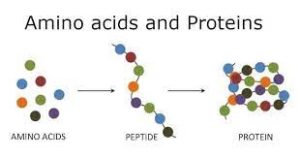 Synthesis occurs in the cytoplasm on the ribosome, which is macromolecular complex of ribosomal RNA and proteins.
Synthesis occurs in the cytoplasm on the ribosome, which is macromolecular complex of ribosomal RNA and proteins.
Body structural proteins are constantly being synthesized and degraded and even individual amino acids are in a state of dynamic interconversion.
Made up of large numbers of amino acids linked by peptide bonds joining amino groups of one amino acid to the carboxyl group of the next amino acid.
The process of making proteins encoded by DNA/RNA genetic material is called translation.
Translation involves the step-by-step addition of amino acids to a growing protein chain by a ribosome.
The order in which the amino acids are added is read through the genetic code from an mRNA template, which is an RNA copy of one of the genes.
Messenger ribonucleic acid (mRNA) transfers information from nuclear DNA to the ribosomes.
Messenger RNA is produced in the nucleus by DNA-dependent RNA polymerase which copies the antisense strand of the DNA double helix during transcription.
Abnormalities in protein structure or function as a result of changes in primary amino acid sequence are responsible for disease states
Many proteins are regulated individually and vary under different conditions.
Peptides contain 2-10 amino acids residues, polypeptides contain more than 10 but fewer than 100 amino acid residues and chains containing 100 or more amino acid residues are called proteins.
The order of the amino acids in the peptide chain is referred to as the primary structure of a protein.
Proteolysis is complex controlled and regulated and plays a role in many processes including cell cycle development, cell differentiation, transcription regulation, signal transduction, antigen presentation, receptor mediated endocytosis and modulation of other metabolic pathways.
Vary in stability with half life ranging from a few minutes to many days.
Degradation rates vary with availability of nutrients and hormones.
Inhibitors of lysosomal proteases have different effects on different populations of proteins indicating that classes of proteins are targeted by different proteolytic mechanisms.
Protein folding is the physical process where a protein chain is translated into its native three-dimensional structure.
Typically a “folded” conformation, allows the protein to become biologically functional.
Amino acids interact with each other to produce a well-defined three-dimensional structure, the folded protein resulting three-dimensional structure is determined by the amino-acid sequence or primary structure.
Failure to fold into a native three-dimensional structure generally produces inactive proteins.
In some instances, misfolded proteins have modified/toxic functionality.
